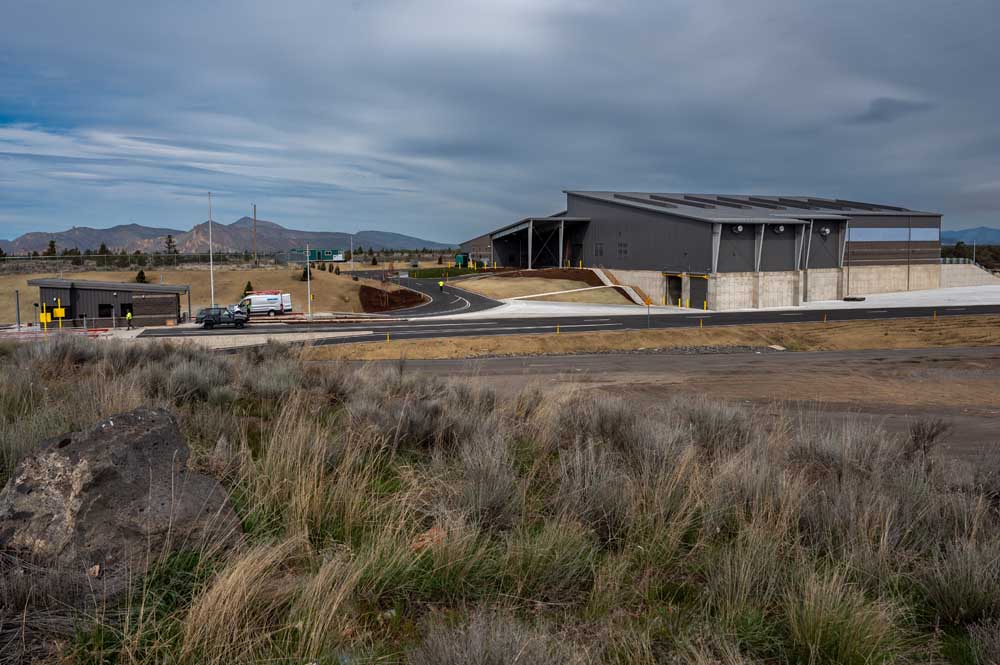Redmond’s Negus Transfer Station gets a $20 million makeover, opens May 20
Published 3:30 pm Tuesday, April 23, 2024

- The new solid waste facility at Negus Transfer Station.
Gone are the days of throwing trash over a fence in the freezing rain or falling snow at the Negus Transfer Station in Redmond.
On May 20, Deschutes County will debut a $20 million renovation that will make disposing of solid waste an indoor activity and improve the efficiency of solid waste transfer to the county’s new landfill.
The renovations largely consist of a new 30,000 square-foot indoor solid waste facility. There, customers will drive inside, deposit their trash and swiftly exit before a bulldozer pushes all the solid waste down a chute leading to transfer vehicles bound for Knott Landfill. Meanwhile, anyone with recyclables or yard waste will be directed to a secondary area.
Tim Brownell, the director of solid waste for Deschutes County, said the need for a more efficient system at the Negus Station has been growing. The new building — which can hold 18-19 cars simultaneously — will expand Negus’s current capacity and account for the additional growth projected in the Redmond area, Brownell said.
“The activity level had gotten to a point where we realized we needed to split the activities — the recycling diverted from the waste — so that we had enough space for vehicles to come through in a timely fashion,” Brownell said. “We’re averaging well over 400 customers coming into the site a day … (and) we were getting wait lines coming out to the front gate.”
Brownell said the old system at Negus Transfer Station posed several difficulties. Before the renovations, customers would unload their waste over a fence and into the tops of transfer vehicles headed to Knott Landfill. Not only was it a miserable experience for staff and customers during bad weather, it was inefficient and posed a public safety risk.
“There have been a couple of occasions when people throwing materials into the truck have actually fallen into the container,” Brownell said. “We want to get completely away from that.”
The new solid waste facility is safer on multiple levels, he said. There is no ice for people to slip on, waste is deposited by customers directly onto the concrete floor and all debris is pushed by machinery to the rear of the building towards a chute that leads to transfer vehicles. Even the safety gate that guards the chute has additional safety features, said construction project manager Ned McFarlane.
The system will also be more efficient, Brownell explained, because vehicles will be weighed using scales at the entrance and the exit of the Negus Transfer Station. This will help workers quickly move customers through the gate and tabulate how much waste is coming into the facility more accurately.
“We’ll weigh loads as people come in … They’ll drop the material off, and then they’ll head back out of the building and go over the scales again. Now they’ll be paying by weight, which will be much more accurate as opposed to an estimated volume. If people ever had concerns around, ‘you’re mis-measuring me,’ now we’ll know to the pound,” said Brownell.
Once the renovated facility at Negus Transfer Station opens in May, the rates customers are charged will transfer from a volume-based rate to a weight-based rate. Similar to Knott Landfill, the rates will be $24 for loads 0 to 400 pounds and additional $7 for each additional $200 pounds. For loads that are properly secured and covered, the county offers a $10 rebate.
The new facility will also allow Negus to expand certain services. Instead of a yearly hazardous waste event, Brownell said he hopes to turn that into a monthly event. Construction debris will also be expanded from four cubic yards to ten cubic yards, an important addition that will keep contractors from driving out to Crook County to deposit construction waste, Brownell said.
Being able to tabulate how much waste is coming in and out of Negus Transfer station is especially important because Deschutes County is in the process of scouting locations for a second landfill. Currently, all four transfer stations located throughout the county deposit waste at Knott Landfill, but Brownell said that facility will reach its permitted capacity by 2030.
“Knowing that we are going to have to haul waste a longer distance, what this facility does is it will allow us to more efficiently load trucks and trailers. We’ll be able to weigh every load and make sure that we’ve reached full maximum capacity on that (transfer) truck … because we’re going to have to haul it somewhere between 25 and 40 miles away,” Brownell said.





